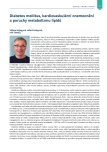Hypertension and diabetes – malignant cardiometabolic combination
Authors:
Hana Rosolová
Authors‘ workplace:
Centrum preventivní kardiologie, II. interní klinika LF UK a FN Plzeň
Published in:
AtheroRev 2019; 4(2): 87-90
Category:
Reviews
Kombinace diabetes mellitus (DM) a arteriální hypertenze (AH) postihuje 4–10 % populace a jejich společný výskyt narůstá s věkem. Tyto choroby nesou vysoké riziko pro výskyt makro- i mikrovaskuárních komplikací, tj. kardiovaskulárních nemocí na podkladě aterosklerózy a diabetické nefropatie, retinopatie a neuropatie. Obě nemoci jsou fenotypicky velmi heterogenní, ale rizikové faktory pro jejich vznik jsou podobné a mají původ v dnešním životním stylu a životním prostředí. Důležitým „mezistupněm“ v rozvoji AH a DM 2. typu (DM2T) je metabolický syndrom, jehož podkladem je inzulinová rezistence. Tento stav je reverzibilní, a proto je jeho ovlivnění v primární prevenci DM2T kruciální. Pokud je diagnostikován DM a AH, je třeba včas zahájit nefarmakologická opatření i vhodnou farmakologickou léčbu hypertenze, DM i dyslipidemie. Jsou uvedeny nejvhodnější léky a jejich kombinace podle současných evropských doporučení.
Overview
Combination of diabetes mellitus (DM) and arterial hypertension (AH) affects about 4–10% of population and their joint prevalence is increasing with age. Those diseases bring high risk of macro - and microvascular complications, i.e. atherosclerotic vascular diseases and diabetic nephropathy, retinopathy and neuropathy. The both diseases are heterogeneous in phenotype, but their risk factors are similar and are present in our life style and environment. Metabolic syndrome represents the interstage between AH and type 2 DM (T2DM) and insulin resistance is the background of it. Metabolic syndrome is reversible and therefore its influencing is crucial in primary prevention of T2DM. If AH and T2DM are diagnosed, to start very early non-pharmacological measures and pharmacotherapy for hypertension, diabetes and dyslipidemia are very important. The most appropriate drugs and their combination by the up to date European Guidelines are mentioned.
Keywords:
arterial hypertension – insulin resistance – management of hypertension in diabetics – prevention of macro- and microvascular complications
Sources
- Ogurtsova K, da Rocha Fernandes JD, Husng Y et al. IDF Diabetes Atlas: Global estimates for the prevalence of diabetes for 2015 and 2040. Diabetes Res Clin Pract 2017; 128 : 40–50. Dostupné z DOI: <http://dx.doi.org/10.1016/j.diabres.2017.03.024>.
- Mills KT, Bundy JD, Kelly TN et al. Global disparities of hypertension prevalence and control: a systemic analysis of population-based studies from 90 countries. Circulation 2016; 134(6): 441–450. Dostupné z DOI: <http://dx.doi.org/10.1161/CIRCULATIONAHA.115.018912>.
- Cífková R. Hypertenze a diabetes mellitus. In: Widimský J et al. Hypertenze. Triton: Praha 2002 : 291–301. ISBN 80–7254–249–4
- Facchini FS, Hollenbeck CB, Jeppesen J et al. Insulin resistance and cigarette smoking. Lancet 1992; 339(8802): 1128–1130. Erratum in Lancet 1992; 339(8807): 1492.
- Alberti KG, Eckel RH, Grundy SM et al. Harmonizing the Metabolic Syndrome: a Joint Interim Statement of the International Diabetes FederationTaskForce on Epidemiology and Prevention; National Heart, Lung, and Blood Institute; American Heart Association; World Heart Federation; International Atherosclerosis Society; and International Associationforthe Study of Obesity. Circulation 2009; 120(16): 1640–1645. Dostupné z DOI: <http://dx.doi.org/10.1161/CIRCULATIONAHA.109.192644>.
- Matthews DR, Hosker JP, Rudenski AS et al. Homeostasis model assessment: insulin resistance and beta-cell function from fasting plasma glucose and insulin concentrations in man. Diabetologia 1985; 28(7): 412–419.
- Reaven GM. The metabolic syndrome or the insulin resistance syndrome? Different names, different concepts and different goals. Endocrinol Metab Clin Ann 2004; 33(2): 283–303. Dostupné z DOI: <http://dx.doi.org/10.1016/j.ecl.2004.03.002>.
- Osler JR, Materson BJ, Epstein M. Diabetes mellitus and hypertension. Cardiovasc Risk Factors 1990; 1 : 25–46.
- Morrish NJ, Tevens LK, Head J et al. A prospective study on mortality among middle-aged diabetic patients (WHO Multinational Study of Vascular Disease in Diabetics) II: Associated risk factors. Diabetologia 1990; 33(9): 542–548. Erratum in Diabetologia 1991; 34(4): 287.
- Koulis C, Watson AM, Gray SP et al. Linking RAGE and nox in diabetic micro - and macrovascular complications. Diabetes Metab 2015; 41(4): 272–281. Dostupné z DOI: <http://dx.doi.org/10.1016/j.diabet.2015.01.006>.
- Nenna A, Nappi F, Avtaar Singh S et al. Pharmacologic approaches against advanced glycation end products in diabetic cardiovascular disease. Res Cardiovasc Med 2015; 4(2): e26949. Dostupné z DOI: <http://dx.doi.org/10.5812/cardiovascmed.4(2)2015.26949>.
- Ridker PM, Everett BM, Thuren T et al. Antiinflammatory therapy with canakinumab for atherosclerosis disease. NEJM 2017; 377(12): 1119–1131. <http://dx.doi.org/10.1056/NEJMoa1707914>.
- [Heart OUtcomes Prevention Evaluation Study Investigators]. Effect of ramipril on caardiovascular and microvascular outcomes in people ITL diabetes mellitus: results of the HOPE study and MICRO-HOPE substudy. Heart Outcomes Prevention Evaluation Study Investigators. Lancet 2000; 355(9200): 253–259. Erratum in Lancet 2000; 356(9232): 860.
- Patel A, MacMahon S, Chalmers J et al. [ADVANCE Collaborative Group]. Effects of a fixed combination of perindopril and indapamide on macrovascular and miceŕovascular outcomes in patients with type 2 diabetes mellitus. Lancet 2007; 370(9590): 829–840. Dostupné z DOI: <http://dx.doi.org/10.1016/S0140–6736(07)61303–8>.
- Marso SP, Daniels GH, Brown-Frandsen KB et al. Liraglutide and cardiovascular outcomes in type 2 diabetes. N Engl J Med 2016; 375(4): 311–322. Dostupné z DOI: <http://dx.doi.org/10.1056/NEJMoa1603827>.
- Zinman B, Wanner C, Lachin JM et al. Empagliflozin, cardiovascular outcomes, and mortality in type 2 diabetes. N Engl J Med 2015; 373(22): 2117–2128. Dostupné z DOI: <http://dx.doi.org/10.1056/NEJMoa1504720>.
- Wiviott SD, Raz I, Bonaca MP et al. [DECLARE – TIMI 58 Investigators]. Dapagliflozin and Cardiovascular Outcomes in Type 2 Diabetes. NEJM 2019;380(4):347–357. Dostupné z DOI: <http://dx.doi.org/10.1056/NEJMoa1812389>.
- World Heart Organization. Global atlas on cardiovascular disease prevention and control. Policies, strategies and interventions. WHO Press 2011. ISBN 978 92 4 156437 3. Dostupné z WWW: <https://www.who.int/cardiovascular_diseases/publications/atlas_cvd/en/>.
Labels
Angiology Diabetology Internal medicine Cardiology General practitioner for adultsArticle was published in
Athero Review

2019 Issue 2
Most read in this issue
- The role of bilirubin in diabetes, metabolic syndrome and cardiovascular diseases
- New hypolipidemic agents in the treatment of diabetic dyslipidemia
- Effect of novel anti-diabetic medication on cardiovascular risk
- Hypolipidemic treatment and microvascular complications of diabetes
